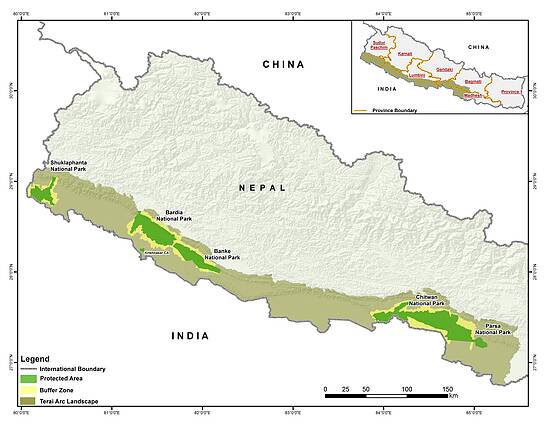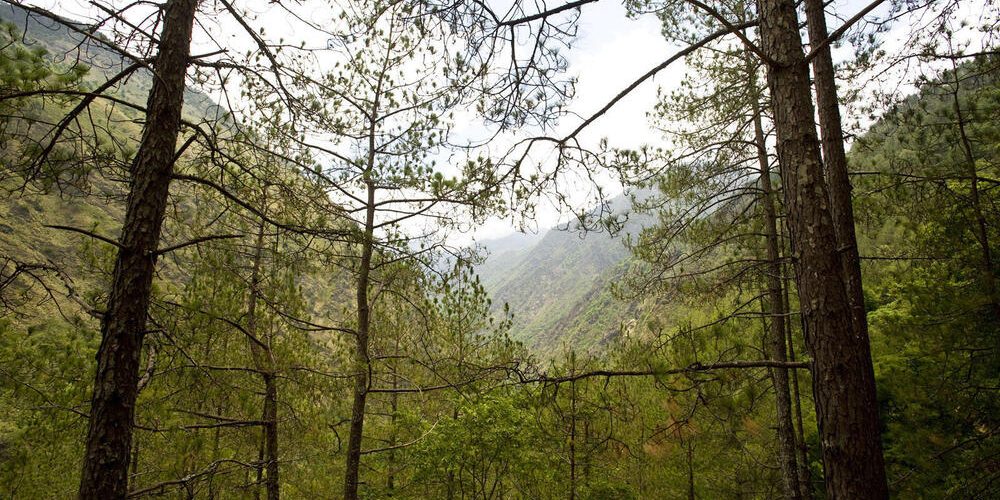Located in the foothills of the Himalayas, the trans-boundary Terai Arc belt stretches from Nepal’s Bagmati River in the east to India’s Yamuna River in the west, connecting 16 protected areas across both countries (WWF, 2021).
In Nepal, the Terai Arc Landscape (TAL) covers a vast area of 24,710 km2 with a network of six protected areas (PAs) and associated buffer zones, which together cover 5,538 km2 connected by seven forest corridors that also link to the Churia forests and Indian PAs, agricultural lands and wetlands.
The Terai has a mosaic of land uses and habitat types, with 54% of the TAL land area occupied by forests and 35% occupied by agriculture. Of the 14,581km2 forest in TAL Nepal, nearly 25% of the forest is located inside the six protected areas, highlighting the importance of the buffer zones, corridors, and other community forest areas which together account for the remaining 75% of TAL forest.

Social and Environmental Importance of TAL
The TAL has with critical importance for globally significant biodiversity and ecosystems and for supporting the local livelihoods of more than 7.5 million people, including numerous ethnic and indigenous groups who depend on natural resources for food, fuel, and medicine, etc.
The TAL provides forest and grassland habitat for tiger and its prey, rhino, elephant and many other globally threatened species of flora and fauna, and ecosystem services including watershed protection and water supply, carbon storage and sequestration, soil protection, and provision of fertile agricultural land.
The TAL’s system of protected areas, buffer zones and habitat corridors supports meta-populations of charismatic megafauna, including the Bengal tiger (Panthera tigris tigris), Asian elephant (Elephas maximus), and greater one-horned rhinoceros (Rhinoceros unicornis) as well as a wide range of other globally threatened species, including hog deer (Axis porcinus), swamp deer (Cervus duvaucelii) and sambar deer (Rusa unicolor), Chinese pangolin (Manis pentadactyla), gaur (Bos gaurus), wild dog (Cuon alpinus), vultures, turtles, gharial (Gavialis gangeticus), Gangetic dolphin (Platanista gangetica).
The publication “Connecting Corridors: Terai Arc Landscape” outlines the importance of Nepal’s various biological corridors, conservation interventions, status in terms of functionality, and main challenges.
The WWF/GEF supported the “Integrated Landscape Management to Secure Nepal’s Protected Areas and Critical Corridors (ILaM)” Project. The project seeks to promote integrated landscape management to conserve globally significant forests and wildlife. SETIN is responsible for the Mid-Term Review (MTR) of the WWF/GEF project. We will continue to share information about the project in future posts.
References:
Ministry of Forests and Soil Conservation 2015. Strategy and Action Plan 2015-2025, Terai Arc Landscape, Nepal. Ministry of Forests and Soil Conservation, Singha Durbar, Kathmandu, Nepal.
Thapa, K., Tuladhar, S. (Eds.) 2021. Connecting Corridors. WWF Nepal, Kathmandu, Nepal.
WWF (2021). Terai Arc Landscape. URL: https://www.wwfnepal.org/our_working_areas/tal2/ [Accessed on August 2023]


